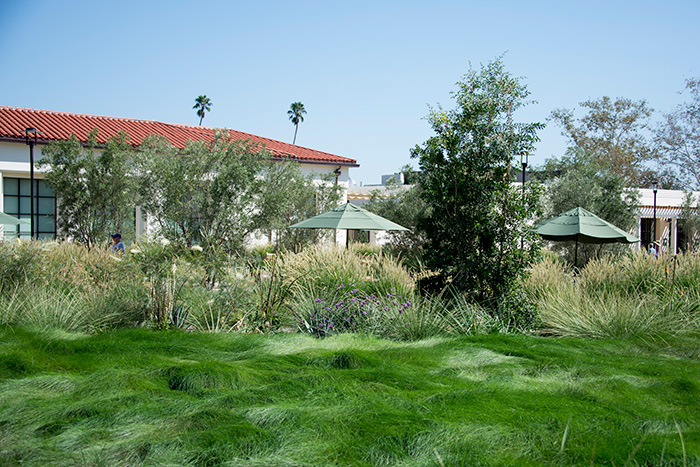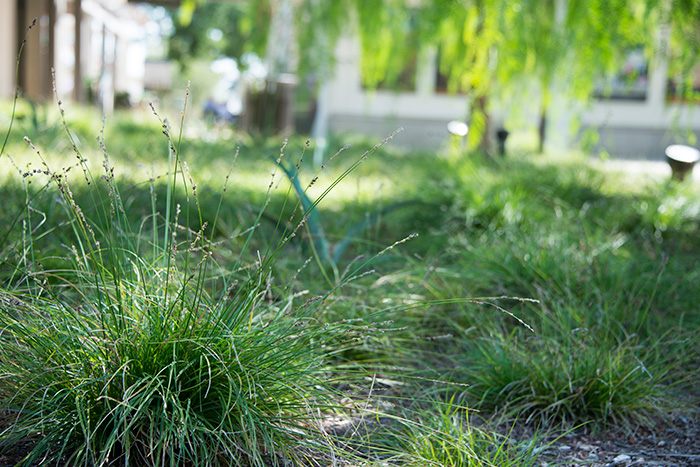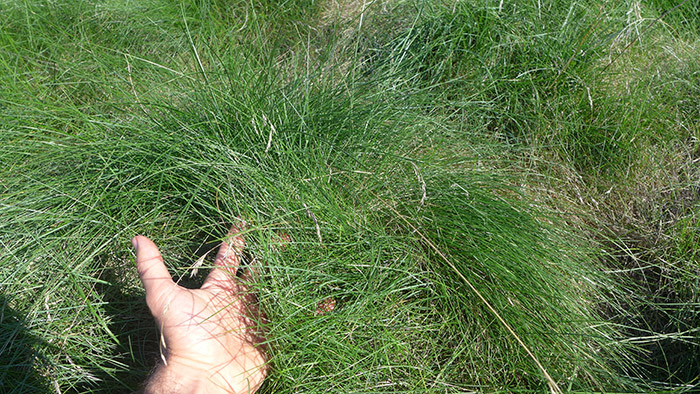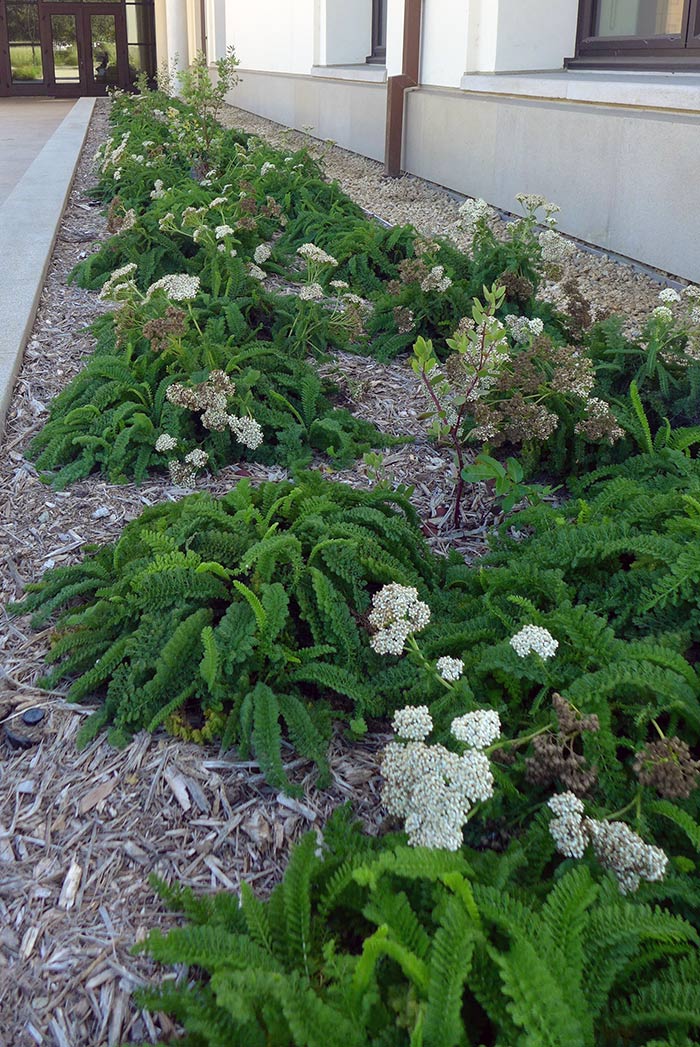The Huntington’s blog takes you behind the scenes for a scholarly view of the collections.
If Not Lawn, Then What?
Posted on Tue., Oct. 6, 2015 by

Want to recreate this wavy meadow look? The “lawn” in front of the Munger Research Center comes from rolls of “Native Mow Free” sod, a mix of three grasses field-grown together. Photo by Kate Lain.
California’s punishing drought has produced one positive effect: local gardens have gained some freedom from the expectation of the classic green lawn. More and more gardeners are removing lawn in favor of landscapes that look good while using less water. The 6.5 acres of gardens in the new Steven S. Koblik Education and Visitor Center contain only a small area of lawn south of the Café terrace, leaving a large area with which to experiment.
Replacing a lawn with a full-fledged garden is one approach, but sometimes there’s an advantage to retaining a simple green surface using lawn alternatives. These areas can be fairly easy to maintain, are good places to lie down or play, and, depending on the choice, may tolerate some amount of foot traffic. They can also show off larger specimen plants in a yard.
Below is a description of some of the plants we’re using in and around the Frances and Sidney Brody California Garden. The suggested growing conditions refer to inland areas of Southern California, such as here in San Marino. Most of these plants will require water once a week until they’re established—more if you’re using small plants and it’s particularly hot. These are just general guidelines; each garden will have its own unique growing environment, so experiment to learn what works best. To find a local supplier, look for nurseries that offer California native plants or drought-tolerant plants. (A list of a few such nurseries in our area is included at the end of this post.)

This short, grass-like sedge, Carex divulsa, grows under pepper trees near the parking lot. Photo by Kate Lain.
European Grey Sedge (Carex divulsa, 12–18 inches tall by 2 feet wide, full sun to full shade)
You can see clumps of this versatile grass-like sedge underneath the California pepper trees between the parking lot and the entrance to the Education and Visitor Center. It’s a tough, low-water option that prefers some shade inland but will grow happily in sun with extra water (or in coastal conditions). This sedge can handle root competition from mature trees and happily accommodates accent plants. In our setting, we’ve added yarrow (Achillea millefolium), octopus agave (Agave vilmoriniana), and shade-tolerant aloes. We used plug-sized plants (plugs are very small plants that come together in a flat), planted 18 inches apart. When using small plants, make sure they stay well watered until they have grown substantially in size. Once mature, plantings will need irrigation only once a week to twice a month in the warm season. This sedge can tolerate some foot traffic in residential settings, but it’s not easy to walk on.

“Native Mow Free” can tolerate some foot traffic. You can also sow wildflower seeds into the mix, which we’ll try this fall. Photo by Scott Kleinrock.
“Native Mow Free” sod (a mix of Festuca idahoensis, Festuca occidentallis, and Festuca rubra, 8–10 inches tall, sold in 2-foot by 5-foot rolls, full sun to significant shade)
We achieved the low, wispy, meadow-like look found outside the Munger Research Center with a group of three California native grasses, field-grown together, then shipped in rolls. This “Native Mow Free” blend takes full sun and is especially comfortable with afternoon or partial shade. Rolling out the sod gives an almost immediate meadow effect. It can be left as is or trimmed (by about a third, once or twice a year with a string trimmer) and can tolerate some foot traffic. You can also sow wildflower seeds into this mix, which we will try this fall. To prepare your area for planting, follow the same guidelines as for any other sod grass. (You can find this information online, in books, or at your local nursery.) It’s best to plant this mix in fall. In hot periods, it will naturally turn a golden brown with less water but become greener with a bit more water. Once established, water the sod once a week to twice a month, depending on conditions.

Yarrow is a tough, evergreen plant that makes a good lawn alternative. But beware: if you let the flower stalks grow and dry out, then mowing becomes difficult. Photo by Scott Kleinrock.
Yarrow (Achillea millefolium, 18–30 inches tall and wide if not mowed, full sun)
Yarrow is a spreading evergreen herbaceous plant. Achillea millefolium, with white flowers, is the common yarrow found in California. (Other cultivars are available in many colors.) This tough plant will tolerate full sun and low-water conditions. To keep it as a low lawn, mow it once or twice a month. Or leave it to grow and flower, reaching a height of up to 3 feet. You can see examples of the dwarf Achillea ‘Sonoma Coast’ north of Rothenberg Hall, planted from 4-inch pots, 18 inches apart. We will let them grow to their full size and flower. Mowing stimulates the young plants to spread. Yarrow lawns can also be grown very economically from seed (similar to preparing a lawn from seed). This approach requires more attention to site preparation, weeding, and watering, at least in the beginning. It’s best to decide ahead of time if a yarrow lawn will be mowed or not because, if left to flower—and if the flower stocks then dry out—then the stocks are difficult to remove with a mower. Yarrow can also grow well in partial shade in inland conditions. It can take regular water, but once established, can live on irrigation once every two weeks or less. Mown yarrow can accommodate a fair amount of residential foot traffic. It’s fine for seating areas or entertaining but not for soccer practice.

Deergrass is easy to grow, drought-tolerant, and large. To show off this plant’s beautiful flower stocks, plant five feet apart. Photo by Kate Lain.
Deergrass (Muhlenbergia rigens, 4–5 feet tall and wide, full sun but can tolerate some shade)
For gardeners not concerned with low or walkable surfaces, a huge variety of low-water use bunch grasses are available and can be complemented by trees, shrubs, and seating areas. Many of these grasses retain their flower stems for a large part of the year and are stunning when backlit. California native deergrass is one of the easiest to grow and most beautiful. You can see it in a variety of areas around the Education and Visitor Center, including the bus drop-off area on the east side of the center. It’s best to use plugs, 4-inch pots, or one-gallon pots, planted 4 to 5 feet apart. Five feet allows for the fullest expression of this plant’s beautiful flower stocks, while four feet gives a fuller clump of foliage. It grows quickly and should be cut back every few years to keep it looking clean and to stimulate growth. Even though it’s a low-water plant, deergrass can tolerate water, making it a good choice in transition areas between a lawn and a low-water landscape. Once established, it continues to look good with water only once a month in the dry season.
Choosing plants to replace a lawn needn’t be complicated, and there are many beautiful, durable, and low-water options available. Give them a try.
A few local suppliers of these plants: Soils Solutions: “Native Mow Free” sod Tree of Life Nursery: Carex divulsa, yarrow, deergrass Theodore Payne Foundation: yarrow, deergrass
Related content on Verso:
It's All About the Soil (June 2, 2015)
A California Garden (March 27, 2015)
Scott Kleinrock is The Huntington’s landscape design and planning coordinator.